Chapter 10: Lady Muck
Then it all went wrong. It started with the arrival of a new site manager who brought with him new guidelines. First the watching of gulls inside the tip was discouraged. Then the gulls themselves were discouraged. The officers at the Environment agency had decided that gulls were vermin and a threat to public health. Blokes with large guns and falcons were brought in, and the gulls were forced to leave.
I had been enjoying the run of rare gulls so, frustrated by this turn of events, I looked around for someone to blame. Who was in charge, I wondered? I googled the CEO of the Environment Agency and there she was, Baroness Young of Old Scone. I realised that I had met her. She had been Chief Executive of the RSPB and had shaken my hand at the Bird Fair. I couldn’t wait to get down the pub for a rant.
There were three candidates for Britain’s rarest successful breeding birds in 2007, the most recent year compiled by Britain’s Rare Breeding Birds Panel. A pair of Green Sandpipers that reared three young in an old Wood Pigeons’ nest in the Scottish highlands, a pair of Fieldfares that managed to produce three young in Derbyshire, and a pure pair of Yellow-legged Gulls that discreetly fledged two young in Poole Harbour.
Graham Armstrong identified the harbour’s first Yellow-legged Gull in Poole Park in February 1982. He saw the first one on the roof of the Kerry Foods pie factory in 1988 after searching unsuccessfully for the Wilson’s Phalarope nearby in Holes Bay. In the early ‘90s a few michahellis, as they were affectionately called then, began to appear here regularly in the late summer, but it was James and Stan who really put Kerry Foods on the birding map.
They usually counted together but fell out temporarily (Nick suggested that it was over a girl), and were soon visiting separately. This lead to a series of Dorset record counts, each one just a bit higher than the last, as they tried to outdo each other. By August 1999, over 200 birds were regularly being counted.
The northerly dispersal of these continental breeding birds in late summer is now an annual event, but numbers have leveled off in recent times. In CD1-39, you can hear a juvenile that Magnus recorded in late August, along the coast at Lodmoor. They used to feed at the pie factory, but now just use it as a pre-roost gathering site, seemingly content to stand around on the rooftops, leaving the regular delivery of pies for other gulls to squabble over. More recently we have discovered that they roost off of the end of Swineham in the Wareham Channel. Both sites now share top spot with around 100 birds each at the peak of the season.
CD1-39: Yellow-legged Gull Larus michahellis Lodmoor, Dorset, England, 10:29, 22 August 2006. Very coarse calls of a juvenile. Background: Common Moorhen Gallinula chloropus, Eurasian Coot Fulica atra, juvenile large gull Larus and Common House Martin Delichon urbicum. 060822.MR.102932.31
With echoes of Little Egret, Brownsea became the site where Britain’s first pair of Yellow-legged Gulls decided to settle. They have bred every year since 1995, and are still the only pure pair ever to have bred in Britain. And that is what fuelled my pub rant: ‘Barbara Young, previous CEO of the RSPB makes the life of Britain’s rarest breeding bird a misery.’ When I suggested this down the pub the others shook their heads. They knew that for many people gulls are vermin.
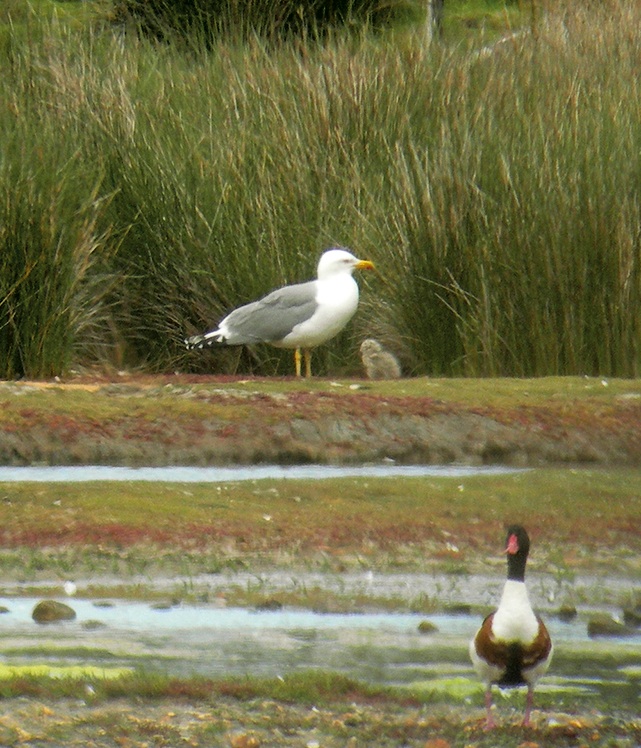
Yellow-legged Gull Larus michahellis, adult with chick, Brownsea lagoon, Dorset, 13 June 2009 (Nick Hopper)
“Gulls don’t have the same rights as other birds”, someone said. I was indignant; “When it comes to conservation, there shouldn’t be a difference between one species and another.” I argued that the Environment Agency should have leeway to look after Britain’s rarest breeding bird when it joins the flocks at Poole’s landfill sites. “But do they join them?” asked Graham. I argued that there had been 40 records at the tip over the years. “Not many when you think of the numbers of birds in the harbour, Mark.” He had a point.
So the Baroness and her henchman weren’t really villains? If I wasn’t able to fit them up with the harassment of Britain’s rarest breeding gull, they still have a case to answer. James moving to the Netherlands for a start, and they stopped Herring Gulls feeding at tips. Now there’s a bird that really is in trouble.
In the ‘40s, Herring Gulls were at a bit of a low, but with the help of new bird protection legislation they were soon back on the increase. The real catalyst however was the introduction of The Clean Air Act in 1956, which banned the burning of rubbish. Together with our increasing willingness to throw food away (currently running at 350 kilos of waste food per person per year), it created an inexhaustible supply of food for the gulls at rubbish tips, which they were quick to exploit.
Things started going wrong on a local level when in 1965 Herring Gulls nesting on Brownsea lagoon had their eggs destroyed to help the terns. Traditionally a cliff-nesting bird, Herring Gulls normally just make scrape nests lined with weeds. On Brownsea, however, the largest number nested in the trees on Caroline Cliffs, the southern high ground behind Brownsea Castle. Here, in what was surely the world’s only tree nesting colony of the species, nests were woven with sticks and lined with moss. At its peak in 1971, there were 930 pairs.
By 1981, Tony Wise could still describe them as “the most numerous breeding bird on Brownsea”, despite the fact that the colony had now nearly halved in number to around 500 pairs. In fact, Herring Gull populations were crashing everywhere, and within a further seven years the colony was down to 100 birds. Nowadays it has gone completely, and there are none breeding on the island.
Maybe the decline in nesting wasn’t just to do with the egg pricking. Traditional cliff-nesting Herring Gull numbers also show a markedly downward trend, halving from 1993 to 2009. Nobody is really sure what is causing the decline. Perhaps the decline in the number of fishing boats has had an influence. Some say that the ecology of our coastal environment is irreparably changing. In 1990, Herring Gulls started nesting on the roofs in Poole Old Town (CD1-40). Working there with them is a delight in my opinion. Whatever the cause, these birds are abandoning the cliffs for the urban lifestyle in order to survive, causing much consternation amongst us their new hosts.
CD1-40: Herring Gull Larus argentatus Poole Old Town centre, Dorset, England, 07:20, 29 March 2009. A wave of long calls of locally breeding adults. Background: Eurasian Collared Dove Streptopelia decaocto and Pied Wagtail Motacilla yarrellii. 090329.MC.072000.01
Herring Gulls are now in such decline that they have joined Dartford Warbler and Nightjar on the Red List of species most in need of conservation. Despite this, the Environment Agency’s real boss, The Department of Environment, Food and Rural Affairs, still issues general licenses that allow Herring Gulls to be killed and their eggs and nests legally destroyed. Perhaps the RSPB should make amends for Baroness Young’s deeds and feature Herring Gull in their Aren’t Birds Brilliant campaign.
Another gull nesting on Poole’s rooftops, although in smaller numbers, is Lesser Black-backed Gull (CD1-41). They are something of an enigma in Poole Harbour. If you walk around Poole Harbour on an average spring or autumn day you would do well to see more than 10 birds, but if you hung around the Wareham Channel on the same evening you could count over 2,000. That’s because for most Lesser Black-backs, Poole Harbour is basically a Travelodge. Both migrants and wintering birds spend the day somewhere else, then as the light begins to fail they come to spend the night in Poole Harbour. Many don’t arrive until it is nearly dark, and many more turn up when we can’t even see them. Then at daybreak they are off again, not even stopping to pick up breakfast.
CD1-41: Lesser Black-backed Gull Larus fuscus Poole Old Town centre, Dorset, England, 07:05, 29 March 2009. Long calls of a pair at the same time. 090329.MC.070500.02
When there is an evening low tide or particularly bad weather, the gulls arrive earlier for a wash and brush up. This is when most of the harbour’s high counts are obtained at Lytchett Bay, which has fresh running water and is ideally placed between Corfe Mullen tip (still used as a pre-roost site after the hawkers have left) and the main Wareham Channel roosts. In 2007, our harbour gull survey included a co-ordinated harbour roost count, which produced a total of 4,850 birds. Some came in very late and were difficult to identify, but the majority were thought to be Herring Gull.
Best species of the 2007 co-ordinated count award went to Dave Chown for his Ring-billed Gull off of Swineham Point. Historically, however, Lytchett Bay is the best place to look for Ring-billed. Shaun found the harbour’s first there on 18 April 1996. Since then, there have been a further 11 records in the harbour, seven of which have been at Lytchett, including three in a year. Unfortunately, much of Lytchett is strictly private, so we really enjoyed the most recent ‘pond jumper’, a very confiding first-year Ring-billed at Poole Park in February 2011, where it could be seen by birders coming to visit our latest Long-billed Dowitcher. We didn’t manage to sound record the Ring-billed, but in case you wonder how they sound, here is a recording of adults in New Jersey (CD1-42). Magnus did record the dowitcher, which considering it was so tame proved to be more difficult than you might imagine (CD1-43).
CD1-42: Ring-billed Gull Larus delawarensis Stone Harbour, Cape May County, New Jersey, USA, 18:30, 25 September 2004. Long calls of adults. Background: Caspian Tern Hydroprogne caspia and Roseate Tern Sterna dougallii. 04.009.KM.01310.01
CD1-43: Long-billed Dowitcher Limnodromus scolopaceus Poole Park, Dorset, England, 16:30, 3 February 2011. Calls of a first-winter, standing on the mud. Background: Canada Goose Branta canadensis and Common Kingfisher Alcedo atthis. 110203.MR.163000.22
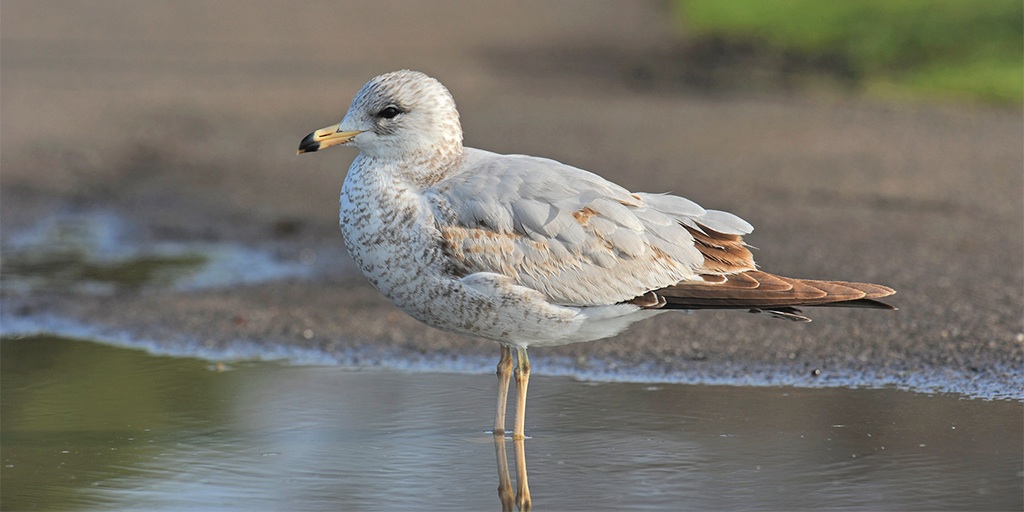
Ring-billed Gull Larus delawarensis, first-winter, Poole Park, Poole, Dorset, 17 February 2011 (Nick Hopper)
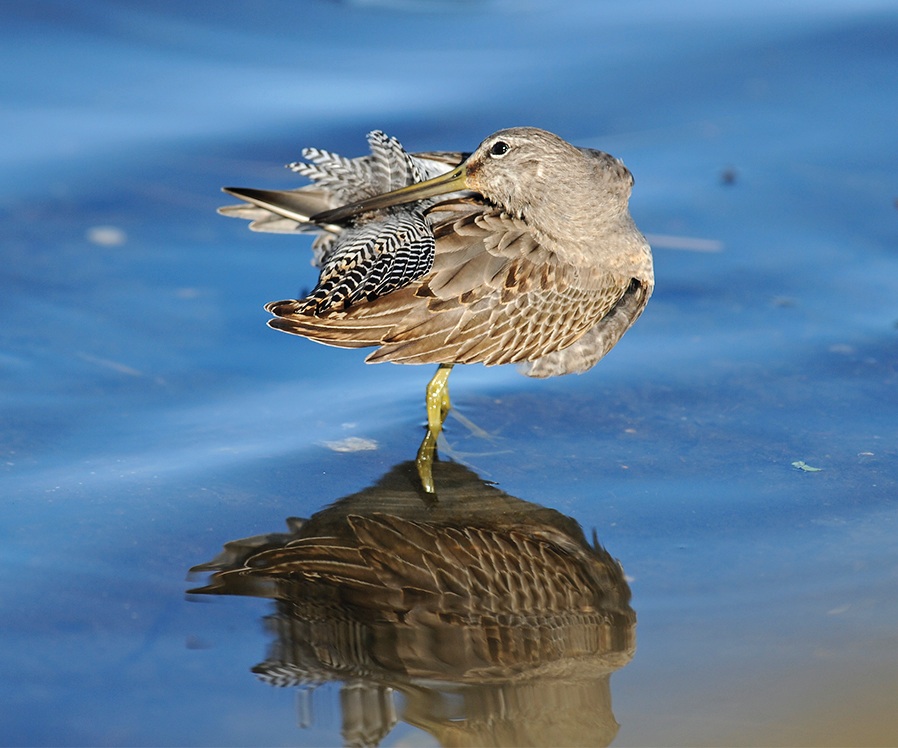
Long-billed Dowitcher Limnodromus scolopaceus, first-winter, Poole Park, Poole, Dorset, 14 February 2011 (Nick Hopper). CD1-43.
The gull count also produced around 21,000 roosting Black-headed Gulls, many of these also having spent their day inland. Nick worked out their daily itineraries by attempting to follow them to and from the roost by car, which proved a little hazardous at times. The furthest birds north were found at Fifehead Magdalen, a little village on the River Stour and an 86 km round trip for the few birds that made it this far. Birds that followed the River Piddle were found as far as Piddlehinton, a 60 km round trip from the Poole roost. Interestingly, these birds actually ended up a lot nearer to the Weymouth Bay roost but chose to remain loyal to the more distant Poole one. Not all birds were quite so adventurous, however. For some their daily trip involved visiting Poole Park where they patiently loafed, waiting for the breakfast to be served at 10:00, when the gates open and the public arrive with bags of stale bread.
If Ben Pond were to come back and look for breeding Black-headed gulls, he would be impressed by their continual adaptation. After being driven from Little Sea, they were pushed from pillar to post by fires, forestation, and most recently commercial egg collecting, which almost finished them off. He would also be glad of the happy ending. Today the colony at Holton Heath islands is nearly 9,000 strong, representing around 5% of the British breeding population. They are being helped in no small part by their continental cousin the Mediterranean Gull, whose discovery on the islands ensured their long-term protection. Fortunately for both species, the islands are not easily visited, so I recorded these Black-headed on the shore at Holton Lee during Lushfest, where they like to socialise (CD1‑44).
CD1-44: Black-headed Gull Chroicocephalus ridibundus Holton Lee, Poole Harbour, Dorset, England, 09:45, 9 April 2004. Calls of adults socialising about 1 km from their breeding colony. Background: Common Redshank Tringa totanus, Icelandic Black-tailed Godwit Limosa limosa islandica, Eurasian Skylark Alauda arvensis, Dunnock Prunella modularis, Common Chaffinch Fringilla coelebs and European Greenfinch Chloris chloris. 04.005.MC.01200.21

Black-headed Gulls Chroicocephalus ridibundus, Brownsea lagoon, Dorset, 6 June 2009 (Claire Lodge)
Ewan Brodie found the first Mediterranean Gull in the harbour as it bathed on Little Sea in the afternoon of 20 April 1976. In May the following year Keith Godfrey found a breeding pair on Brownsea. They attempted to breed but without success. Still, this got everybody’s pulses racing. In 1986 Dave Collins, while doing his survey in the harbour, discovered a pair of summer plumage birds frequenting the Holton Heath islands, and realised that they must be breeding among the Black-headed Gulls.
At the time, gulls’ eggs were being collected by local fishermen under license, but Mediterranean Gull was a Schedule 1 bird and could not be disturbed. The locals had a good thing going selling the eggs off as Quails’ eggs, and they were not going to give up that easily, but despite their protestations, the egg collecting licenses were revoked in 1990, by which time there were six pairs of Mediterranean Gulls on the islands.
The egg collectors were peeved and carried out nocturnal raids, so the RSPB had to coordinate watches, helped by us volunteers and Dorset Police’s Marine Section. As John Day wrote, however, this was not enough. “Unfortunately the surveillance of the colonies has not prevented many of the eggs laid in early April from illegally being taken in some years. When culprits have been caught, they have been prosecuted. Even court cases and publicity did not stop the whole colony being totally collected out between early April and the 20th April 1996” (Pickess & Underhill-Day 2002).
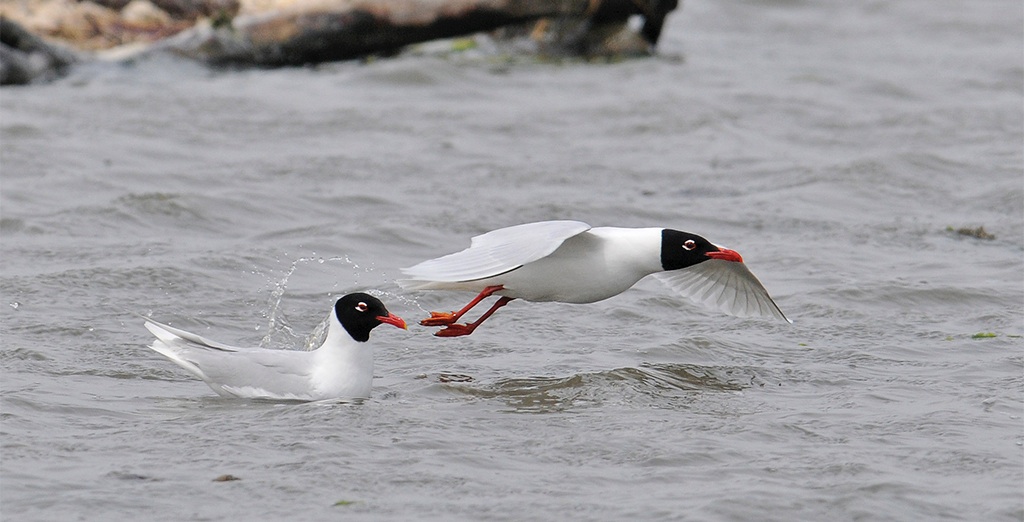
Mediterranean Gulls Larus melanocephalus, adults in summer plumage, Brownsea lagoon, Dorset, 6 June 2009 (Nick Hopper)
Numbers have since increased dramatically, with an RSPB survey in early May 2008 conservatively counting 87 Mediterranean Gull nests. As expected, there was also evidence of a few nests being washed away by the flood tide. Adult summer Mediterranean Gull is a very handsome bird. If you haven’t seen one you are in for a treat. Brownsea lagoon in April is the best place for close views. Here the rather vocal summer plumaged adults, often already in pairs, can be seen practicing their courtship techniques before they move onto the breeding islands. But they can be seen at many other places in the harbour as well. The two in CD1-45 were passing the rookery at Ower Quay on their way towards Studland Bay. Listen to the distinctive low-high-low inflection of their call note. Although they do have other sounds in their repertoire, this is the one that nearly always alerts us to their presence, so it is a very useful call to learn.
CD1-45: Mediterranean Gull Larus melanocephalus Ower Quay, Poole Harbour, Dorset, England, 10:00, 18 April 2010. Typical calls of two adults on their way to Little Sea. Background: Barn Swallow Hirundo rustica, European Robin Erithacus rubecula, Rook Corvus frugilegus, European Blue Tit Cyanistes caeruleus and Common Chaffinch Fringilla coelebs. 100418.MC.100000.02
Baiter is another favourite pre-breeding haunt. Late afternoons are best here, when birds gather on the shoreline before going to roost. Up to 40 adult birds have been counted here recently, providing a real treat as I cycle past on the way home from work. Post-breeding sees birds heading back to a traditional wintering area at Studland Bay. From as early as June, failed breeders arrive to join up with the few immature birds that have spent all summer here. Later, numbers are supplemented by the year’s juveniles, many bearing foreign leg rings, having already crossed the channel. In CD1-46, you can hear how juvenile Mediterranean Gulls sound in early autumn. A good time to hear them is when they are feeding on flying ants, as was the case when Magnus made this recording in Bulgaria.
CD1-46: Mediterranean Gull Larus melanocephalus Durankulak lake, Dobrich, Bulgaria, 09:40, 17 September 2007. A large flock, almost all juveniles, feeding on flying ants. Background: Black-headed Gull Chroicocephalus ridibundus, Eurasian Penduline Tit Remiz pendulinus and Bearded Reedling Panurus biarmicus. 070917.MR.094028.00
Nick has been keeping his eye out for ringed birds here for the past few years, recording birds from France, Belgium, the Netherlands and Germany. Sending in bird ring sightings doesn’t always guarantee a reply, so he was pleasantly surprised to receive a rather excited email from some Germans who had ringed one of the Studland birds as a pullus, even sending him a photo of ‘their’ bird as a youngster.
Pim Wolf, a dedicated birder and ringer from Zeeland in the southwest of the Netherlands, also had reason to be excited on 28 August 2008. After a morning being shown the delights of Poole Harbour by Nick and Magnus, they all stopped off at Studland’s South Beach café for some refreshments. While getting through their pasties and hot chocolate, they found three Belgian-ringed birds, one of which Pim himself had ringed as a chick.
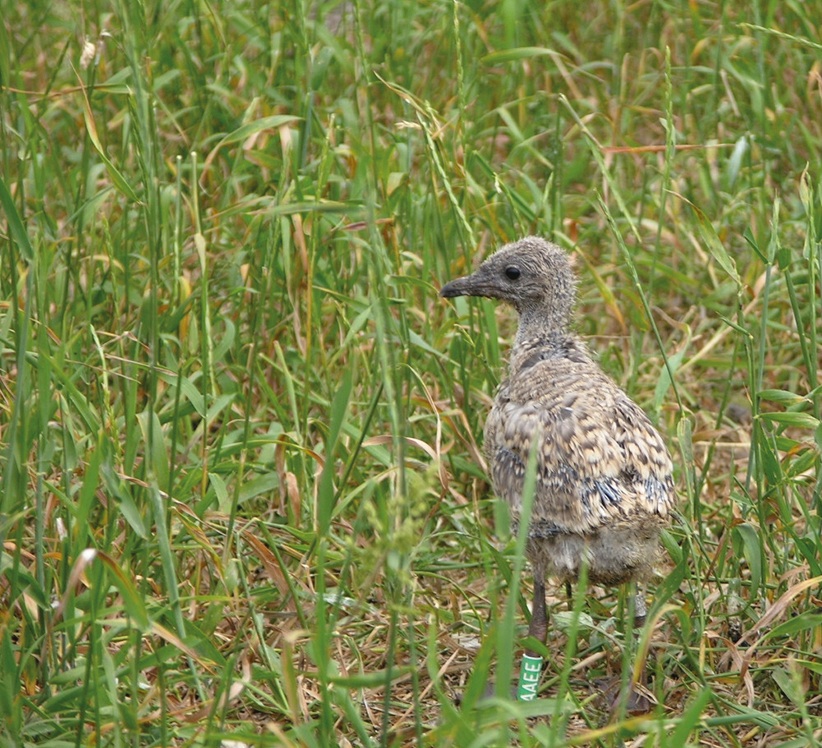
Mediterranean Gull Larus melanocephalus, chick, colour ringed (AAEE), Pionierinsel Lühe, Landkreis Stade, Niedersachsen, Germany, 17 June 2006 (Simon Hinrichs). This German chick was photographed as an adult by Nick at Studland Bay on 9 October 2009.
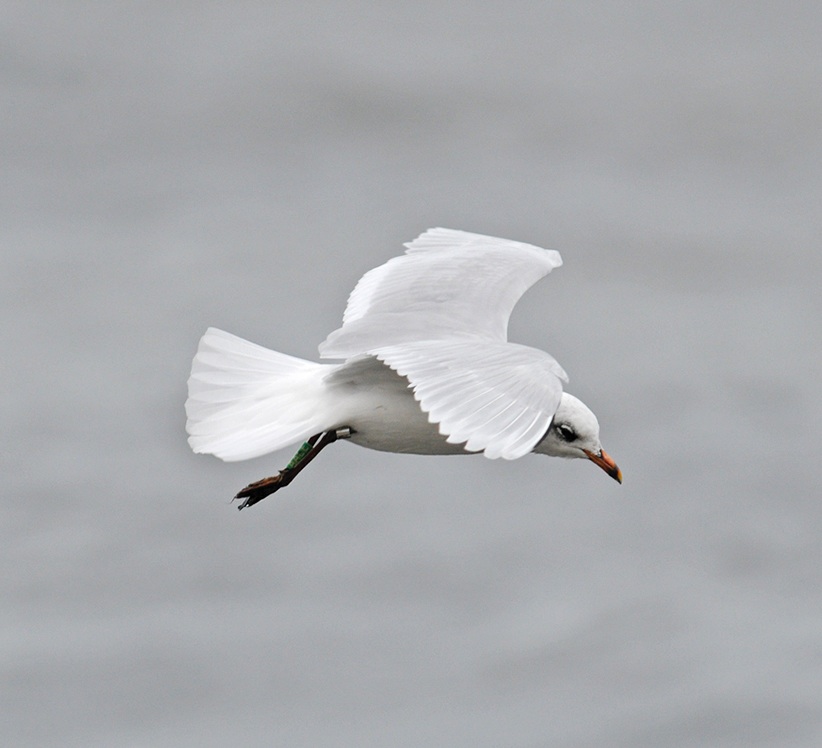
Mediterranean Gull Larus melanocephalus, adult, ringed in Germany (AAEE), Studland Bay, Dorset, 9 October 2009 (Nick Hopper)
As winter progresses some birds move on, but good numbers can still be seen here. They like to feed on the invertebrates in the seaweed. This normally just involves a bit of pecking. Sometimes if the prey jumps, the bird may have to leap and catch it in mid-air. If the weather is bad, they scavenge among the flotsam and jetsam in the bay. Even really rough weather with gale force winds will not deter them from feeding among the large breakers, at a time when most other gulls are keeping their heads down. CD1-47 was recorded in early January in Portugal, and may well involve birds that have passed through Poole Harbour. Research has shown that Portugal is the main wintering area for Mediterranean Gulls from northern Europe (Poot & Flamant 2006).
CD1-47: Mediterranean Gull Larus melanocephalus Foz de Lizandro, Lisboa, Portugal, 12:58, 10 January 2011. Calls of first-winters and adults bathing and displaying aggressively. For much of the non-breeding season, the best-known call of adults (CD1-45) is rarely heard, and you are more likely to hear harsh calls associated with feeding and aggression. From late winter onwards, the smoother calls return. Background: Eurasian Wren Troglodytes troglodytes. 110110.MR.125850.32
Returning to James Lidster, before moving to the Netherlands, he did achieve one last ambition. While he was surveying the gulls off of the Holton Heath islands for this book in the late afternoon of 17 January 2008, he realised that there were so many birds coming in that he just couldn’t keep up and so abandoned the count. He decided to settle for just scanning through the many Common Gulls to search for something interesting, perhaps a Ring-billed Gull. Then in the failing light he came across a small, dark-mantled gull. He had to do a double take, not quite able to believe what he was looking at. After some panic then a moment’s composure he had a proper look. It was obviously small with a diminutive, all-dark bill and he could make out white eye-crescents. He was watching a Franklin’s Gull.
Further panic ensued as he tried to phone everyone, while at the same time taking a photo with the same phone in the failing light. Nick jumped in his car and drove for all he was worth, through Wareham up through Sandford and along the heavily pot-holed road down to Holton Lee. Nick ran from the car, adrenalin pumping through his system, and after a rather desperate sprint up the fields, across the bridge and through the bramble strewn path, he scrambled frantically down the bank to the shoreline. He reached James’s scope gasping for breath and shoved his eye to the eyepiece, just in time. As for Mo and I, we got there a little too late to see it. We tried a couple more times, but no luck. It’s on Nick’s list and I know he saw it, but sometimes I’m not so sure he has the same confidence in me…